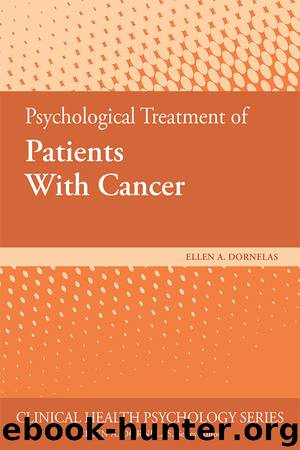Psychological Treatment of Patients With Cancer by Ellen A. Dornelas

Author:Ellen A. Dornelas
Language: eng
Format: epub
Publisher: American Psychological Association
7
Sexual Dysfunction and Negative Body Image
Many cancer treatments have a substantial negative impact on sexual function. During medical encounters, this important topic is often inadequately discussed. Sexuality is a complicated, multidimensional construct, with much still to be learned about typical sexual functioning in healthy people without cancer. The literature about sexual function across the broad spectrum of cancers is limited. The two most common cancers, breast and prostate, are sex specific, although in rare cases breast cancer also occurs in men. Erectile dysfunction is the most common presentation of sexual side effects in men with prostate cancer. Erectile dysfunction is the norm, rather than the exception for men who have undergone radical prostatectomy and external beam radiation therapy. About half of women who have undergone treatment for breast or gynecological treatment report persisting sexual difficulties (Maiorino, Chiodini, Bellastella, Giugliano, & Esposito, 2016). Approximately 40% of men who have been successfully treated for testicular cancer have persistent erectile dysfunction (Wiechno, Demkow, Kubiak, Sadowska, & Kaminska, 2007). The prevalence of clinically significant sexual side effects in people with other types of cancer varies widely depending on many factors, including the domain of sexual functioning that is assessed, extent of surgical intervention, age, relational quality, comorbid psychiatric conditions, and severity of illness. Research in this field is usually based on self-report and presurgical assessment of sexual functioning is rare. Thus, it is somewhat difficult to evaluate the trajectory of sexual dysfunction prior to, during, and following cancer treatment because the topic is sensitive and few data sources are available.
Loss of desire, loss of sensation, and inability to reach orgasm are distressing side effects of cancer treatment that often do not fully remit after treatment has ended. Dyspareunia (painful intercourse) in women and inability to ejaculate in men are also common. Younger men with localized prostate cancer and normal presurgical sexual function prior to radical prostatectomy treatment are more likely to recover sexual functioning within 1 year, but substantial numbers of survivors of prostate cancer report erectile dysfunction (Schover et al., 2002). Female breast cancer patients and patients with gynecological cancer commonly experience vaginal dryness and low libido during and following treatment. Ovarian and other gynecologic cancers of the cervix, vagina, vulva, or uterus are all associated with sexual dysfunction (Maiorino et al., 2016). Cancers of the male reproductive system, such as testicular cancer, also are associated with sexual difficulties. Localized testicular cancer has a very high (95%) survival rate and usually occurs in men between the ages of 20 and 39; the risk for lasting sexual side effects is high. Risk factors for sexual dysfunction in people with colon cancer are location of the cancer, type of surgery, radiation therapy, presence of a stoma, and older age (Traa, De Vries, Roukema, & Den Oudsten, 2012).
Surgery, radiation therapy, and some types of chemotherapy substantially influence interest in or ability to enjoy sexual intercourse. Androgen deprivation therapy for metastatic prostate cancer is associated with lower testosterone levels, reduced libido, and decreases in the size and length of the penis (Kim, 2011).
Download
This site does not store any files on its server. We only index and link to content provided by other sites. Please contact the content providers to delete copyright contents if any and email us, we'll remove relevant links or contents immediately.
Periodization Training for Sports by Tudor Bompa(8171)
Why We Sleep: Unlocking the Power of Sleep and Dreams by Matthew Walker(6618)
Paper Towns by Green John(5092)
The Immortal Life of Henrietta Lacks by Rebecca Skloot(4526)
The Sports Rules Book by Human Kinetics(4296)
Dynamic Alignment Through Imagery by Eric Franklin(4118)
ACSM's Complete Guide to Fitness & Health by ACSM(3989)
Kaplan MCAT Organic Chemistry Review: Created for MCAT 2015 (Kaplan Test Prep) by Kaplan(3940)
Introduction to Kinesiology by Shirl J. Hoffman(3726)
Livewired by David Eagleman(3685)
The Death of the Heart by Elizabeth Bowen(3553)
The River of Consciousness by Oliver Sacks(3542)
Alchemy and Alchemists by C. J. S. Thompson(3451)
Bad Pharma by Ben Goldacre(3357)
Descartes' Error by Antonio Damasio(3231)
The Emperor of All Maladies: A Biography of Cancer by Siddhartha Mukherjee(3068)
The Gene: An Intimate History by Siddhartha Mukherjee(3049)
The Fate of Rome: Climate, Disease, and the End of an Empire (The Princeton History of the Ancient World) by Kyle Harper(3006)
Kaplan MCAT Behavioral Sciences Review: Created for MCAT 2015 (Kaplan Test Prep) by Kaplan(2941)
